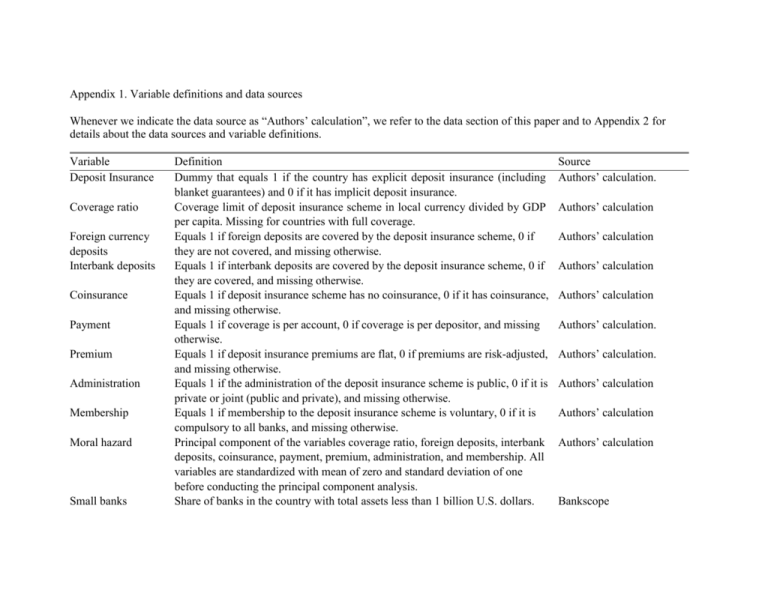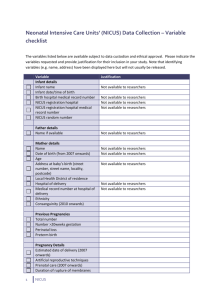DI Adoption_JFI2_Appendix1
advertisement

Appendix 1. Variable definitions and data sources Whenever we indicate the data source as “Authors’ calculation”, we refer to the data section of this paper and to Appendix 2 for details about the data sources and variable definitions. Variable Deposit Insurance Coverage ratio Foreign currency deposits Interbank deposits Coinsurance Payment Premium Administration Membership Moral hazard Small banks Definition Dummy that equals 1 if the country has explicit deposit insurance (including blanket guarantees) and 0 if it has implicit deposit insurance. Coverage limit of deposit insurance scheme in local currency divided by GDP per capita. Missing for countries with full coverage. Equals 1 if foreign deposits are covered by the deposit insurance scheme, 0 if they are not covered, and missing otherwise. Equals 1 if interbank deposits are covered by the deposit insurance scheme, 0 if they are covered, and missing otherwise. Equals 1 if deposit insurance scheme has no coinsurance, 0 if it has coinsurance, and missing otherwise. Equals 1 if coverage is per account, 0 if coverage is per depositor, and missing otherwise. Equals 1 if deposit insurance premiums are flat, 0 if premiums are risk-adjusted, and missing otherwise. Equals 1 if the administration of the deposit insurance scheme is public, 0 if it is private or joint (public and private), and missing otherwise. Equals 1 if membership to the deposit insurance scheme is voluntary, 0 if it is compulsory to all banks, and missing otherwise. Principal component of the variables coverage ratio, foreign deposits, interbank deposits, coinsurance, payment, premium, administration, and membership. All variables are standardized with mean of zero and standard deviation of one before conducting the principal component analysis. Share of banks in the country with total assets less than 1 billion U.S. dollars. Source Authors’ calculation. Authors’ calculation Authors’ calculation Authors’ calculation Authors’ calculation Authors’ calculation. Authors’ calculation. Authors’ calculation Authors’ calculation Authors’ calculation Bankscope Variable Definition Average over the period 1995-99. Source Undercapitalized banks Insurance penetration Pop65 Share of banks in the country with capital-to-asset ratio less than the median capital-to-asset ratio in the country. Average over the period 1995-99. Gross insurance premiums underwritten as a share of GDP. Average over the period 1987-2002. Share of population age 65 and over. Bankscope Contagion Fraction of countries in the sample that has adopted explicit deposit insurance at each point in time. Dummy variable that takes a value of one for the years 1999 and onwards, the year 1999 being the year that the IMF endorsed deposit insurance by publishing a paper on best practices and guidelines in deposit insurance, and zero otherwise. Dummy variable that takes the value of one during and following the year that the World Bank started an adjustment lending program with the country for reforms to establish deposit insurance (in addition to possibly other objectives), and zero otherwise. This variable takes a value of one for the following countries and periods (between brackets): Albania (2002 and onwards), Bolivia (1998 and onwards), Bosnia-Herzegovina (1996 and onwards), Croatia (1995 and onwards), El Salvador (1996 and onwards), Jordan (1995 and onwards), Lithuania (1996 and onwards), Nicaragua (2000 and onwards), Poland (1993 and onwards), Romania (1996 and onwards), Russia (1997 and onwards), Ukraine (1998 and onwards). Dummy variable that takes a value of one for the years 1994 and onwards for EU candidate countries only (i.e., Bulgaria, Cyprus, Czech Republic, Estonia, Hungary, Latvia, Lithuania, Malta, Poland, Romania, Slovak Republic, Slovenia), and zero otherwise. The year 1994 was the year when the EU Directive on Deposit Insurance came into force. Authors’ calculation. IMF WB loan EU Candidate WDI WDI Garcia (2000) World Bank (2004) EU (1994) Variable Crisis Definition Dummy variable that takes a value of one in years that the country is experiencing a systemic banking crisis, and zero otherwise. Polity Score Index combining democracy and autocracy scores. It ranges from –10 to 10, where negative scores are assigned to countries under autocracies and positive values to countries under democracies and –10 and 10 are the extreme cases of these two systems. Autocracies sharply restrict or suppress competitive political participation. Their chief executives are chosen in a regularized process of selection within the political elite, and once in office they exercise power with few institutional constraints. Democracy is conceived as three essential, interdependent elements. One is the presence of institutions and procedures through which citizens can express effective preferences about alternative policies and leaders. Second is the existence of institutionalized constraints on the exercise of power by the executive. Third is the guarantee of civil liberties to all citizens in their daily lives and in acts of political participation. Democracy score. It ranges from 0 to 10, with higher scores denoting more democratic systems. Democracy is conceived as three essential, interdependent elements. One is the presence of institutions and procedures through which citizens can express effective preferences about alternative policies and leaders. Second is the existence of institutionalized constraints on the exercise of power by the executive. Third is the guarantee of civil liberties to all citizens in their daily lives and in acts of political participation. Index measuring the extent of institutionalized constraints on the decisionmaking powers of chief executives. Such limitations may be imposed by any accountability group. The index ranges from 1 to 7, where 1 represents unlimited authority and 7 Executive parity or subordination. Democracy Executive Constraints Source Caprio, Klingebiel, Laeven and Noguera (2005) Polity IV, INSCR Program, CIDCM, University of Maryland, College Park Polity IV, INSCR Program, CIDCM, University of Maryland, College Park Polity IV, INSCR Program, CIDCM, University of Maryland, College Park Variable Political Competition GDP per capita Bureaucracy Law & Order Definition Index combining regulation of participation and competitiveness of participation scores. It ranges from 1 to 10, where higher scores represent more political competition. Participation is regulated to the extent that there are binding rules on when, whether, and how political preferences are expressed. One-party states and Western democracies both regulate participation but they do so in different ways, the former by channeling participation through a single party structure, with sharp limits on diversity of opinion; the latter by allowing relatively stable and enduring groups to compete nonviolently for political influence. The polar opposite is unregulated participation, in which there are no enduring national political organizations and no effective regime controls on political activity. In such situations political competition is fluid and often characterized by recurring coercion among shifting coalitions of partisan groups. The competitiveness of participation refers to the extent to which alternative preferences for policy and leadership can be pursued in the political arena. GDP per capita (constant 1995 thousands of US$). Source Polity IV, INSCR Program, CIDCM, University of Maryland, College Park Index measuring the institutional strength and quality of the bureaucracy. It ranges from 0 to 4. High points are given to countries where the bureaucracy has the strength and expertise to govern without drastic changes in policy or interruptions in government services. In these low-risk countries, the bureaucracy tends to be somewhat autonomous from political pressure and to have an established mechanism for recruitment and training. Countries that lack the cushioning effect of a strong bureaucracy receive low points because a change in government tends to be traumatic in terms of policy formulation and day-to-day administrative functions. Average over the period 1984-2002. Index measuring a country’s legal system and rule of law. It ranges from 0 to 6, where a high score indicates high level of law and order. Law and order are assessed separately, with each sub-component comprising zero to three points. International Country Risk Guide (ICRG) WDI International Country Risk Guide (ICRG) Variable Source GDP Growth Definition The law sub-component is an assessment of the strength and impartiality of the legal system while the order sub-component is an assessment of popular observance of law. Average over the period 1984-2002. Real GDP growth rate (in %). Inflation Inflation, GDP deflator (annual %). WDI Fiscal surplus Fiscal surplus to GDP (in %). Positive values denote fiscal surpluses. Negative values denote fiscal deficits. Average over the period 1960-2002, when available. Capital regulatory An index of the stringency of capital regulations in the banking system. The index index captures whether the capital requirement reflects certain risk elements and deducts certain market value losses from capital before minimum capital adequacy is determined. Index ranges from 0 to 7. Higher values denote greater stringency. Data refer to the year 2003. Activity restrictions An index that measures the degree to which banks can engage in securities underwriting and dealing, insurance underwriting and selling, and real estate investment and management. Index ranges from 3 to 12. Higher scores denote more restrictiveness. Data refer to the year 2003. Entry restrictions An index that captures regulatory requirements to obtain a license to set up a bank. Index ranges from 0 to 8. Higher scores indicate greater stringency. Data refer to the year 2003. Official supervisory An index of the extent to which supervisory authorities have the authority to power discipline banks by taking specific actions to prevent and correct problems. Index ranges from 0 to 14. Higher scores denote greater power. Data refer to the year 2003. WDI WDI Barth et al. (2006) Barth et al. (2006) Barth et al. (2006) Barth et al. (2006)






